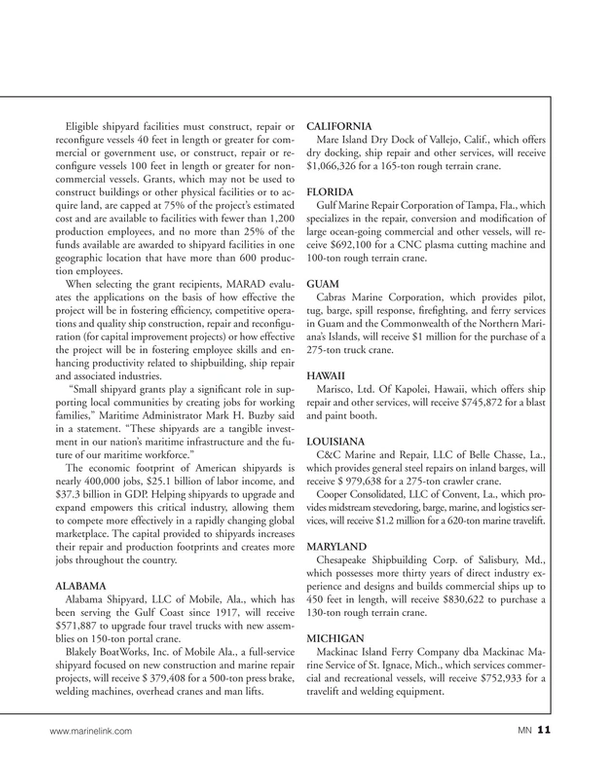
Interview: Bob Merchent, CEO, Halter Marine
Please describe your professional background and what attracted you to your current position.
In June 2020, I was named president and chief executive officer of Halter Marine. I had been retired around six years. My wife and I bought a piece of property outside of Brookhaven, Miss., and we were enjoying retired life split between our country property and our home in Gautier, Miss. Earlier this year, I was asked if I would consider a consulting role for Halter Marine, which led to my eventual position as CEO.
I have a Bachelor’s of Science degree in business management from the University of Southern Mississippi, as well as certificates on executive leadership from the Harvard Business School, executive finance from the Wharton School of Business and executive marketing from the University of Maryland.
I spent most of my career at Ingalls Shipbuilding, leading programs critical to both the business and the U.S. Navy and Coast Guard. Ingalls is an exceptional shipyard building major surface combatants, amphibious assault ships and Coast Guard cutters for the government. Ingalls is true national asset. My time there culminated in the role as the Vice President, Surface Combatants, Fleet Services and U.S. Coast Guard Programs. It’s because of my extensive experience with Coast Guard programs that I was both attracted to the role at Halter Marine and perhaps why I was asked to join the company. During my time at Ingalls working on the National Security Cutter program, I observed several U.S. Coast Guard commandants state how important our icebreakers were to our national strategy. The fact remains that the few ice breakers we have in service today are way beyond the end of their planned service life. And our nation is incurring exorbitant costs keeping these few assets operational. The bottom line is our nation sorely needs a fleet of new icebreakers in order to fulfill the missions levied on our U.S. Coast Guard team today. The new Polar Security Cutter’s mission is to maintain defense readiness in the Arctic and Antarctic regions; enforce treaties and other laws needed to safeguard both industry and the environment; provide ports, waterways and coastal security; and provide logistical support – including vessel escort – to facilitate the movement of goods and personnel necessary to support scientific research, commerce, national security activities and maritime safety.
This is the main reason I took on this job. So, I am delighted to be here at Halter Marine. We have an outstanding team of folks who are just as excited as I am to be responsible for the detail design and construction of the next fleet of Polar Security Cutters.
What is your top goal as Halter Marine’s new CEO, and what’s being done to achieve it?
Halter Marine has a wonderfully storied legacy and an excellent reputation for shipbuilding. We have served our nation faithfully over the years by designing and constructing government and commercial ships, and we are proudly building on that reputation. I want to see Halter Marine excel as a strong Tier 2 shipbuilder, contributing to our nation’s defense and security. To get there, we are leveraging our existing capabilities, realigning our organization, improving our business processes and expanding our technology and training. The government requires that we comply with a number of new standards and business processes as part of our Polar Security Cutter (PSC) contract. As a result, many of the changes we are making today will ensure we meet these new requirements.
There has been a great deal of interest in the Polar Security Cutter. We won this contract last year, and we are in the process of designing the vessel and preparing for the start of construction of this highly specialized and unique ship. This program takes advantage of our deepwater facilities, our experience with diesel electric propulsion systems, our ability to build complex vessels and extensive experience in reducing lifecycle operating costs through optimal design.
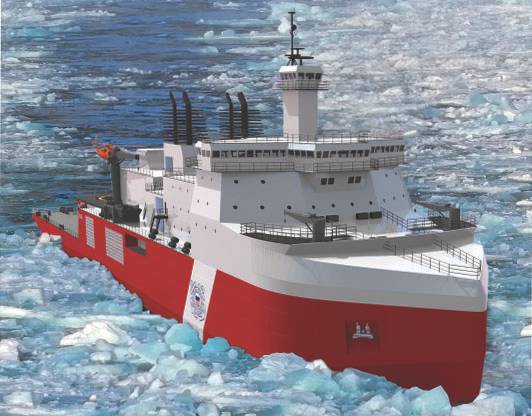 Rendering of the new Polar Security Cutter (Image: Halter Marine)
Rendering of the new Polar Security Cutter (Image: Halter Marine)
Halter Marine is known worldwide for our capability to fabricate and assemble steel vessels extremely efficiently. The Polar Security Cutter will enable us to add yet another unique and specialized capability to our shipyard: the ability to cut and form extremely thick and high tensile steel into units that will ultimately become the finished vessel. We are conducting a pilot program under a special study to develop efficient processes in the cutting and welding of the specialized steel that will be used in the construction of the vessel. These early activities allow Halter Marine to gain knowledge, demonstrate capabilities and mitigate risks well before the actual start of construction.
As we prepare for construction of the PSC, we are also bringing in new technologies such as robotic welding machines and a PythonX, which will increase our steel cutting capacity and expertise. Bringing in high-tech tools such as these ensures that we will be ready when construction begins late next year. Additionally, our entire build position, translation and launch process is being overhauled and upgraded to handle the extreme weight of the Polar Security Cutter. The footprint of the keel area highly loads our ship erection and launch facility that demands significant upgrades to their foundations, all the way down to bedrock.
In addition to the equipment and facilities, we are also investing in our workforce. To help develop our future workforce, we have just implemented a U.S. Department of Labor-approved, four-year apprenticeship program and our first group consists of 50 people across five crafts. Constructing the PSC requires that we double our workforce in the coming months, so we are training talented and capable men and women today to be part of that skilled labor force. As a large, multi-year program, the PSC makes us more attractive to future employees and equally important, it will help us retain the highly trained workforce we have today.
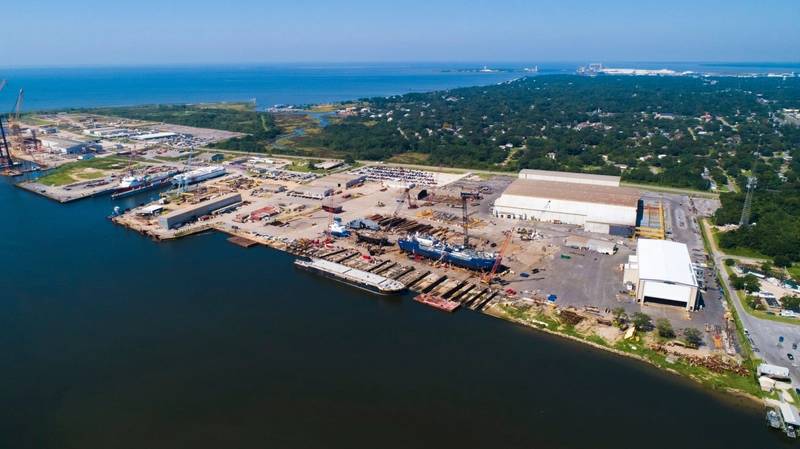 The Halter Marine shipyard in Pascagoula (Photo: Halter Marine)
The Halter Marine shipyard in Pascagoula (Photo: Halter Marine)
What do you count as your greatest challenge, and what’s being done to address it?
Halter Marine is currently in the middle of what is called the functional design phase for the PSC. This is where we do all the ship systems integration. We have 13 major teammates who provide both technical and material components that make up the vessel. Many of them are located overseas. The functional design process involves a series of concurrent technical and programmatic activities across all these major teammates. Communication across this enterprise is paramount in order to be successful in this phase of design. The process associated with the design of a new vessel is a challenge by itself. But doing this under the constraints introduced by COVID-19 has made it particularly challenging. However, our team has leveraged technology to the fullest extent we can and we have improved our processes to minimize the impacts of COVID. We, along with our Navy and Coast Guard teammates are working side-by-side to overcome the adverse impacts of COVID, protect our workforce and customers and ensure we continue to make progress in spite of these many challenges.
Of course, strengthening and increasing our skilled labor force for the PSC is both a blessing and a challenge. That’s why we teamed up with the Mississippi Gulf Coast Community College to create our apprenticeship program. It offers training in the craft labor fields of welding, ship fitting, pipe fitting, pipe welding and electrical. It is designed in three components: on-the-job training, classroom training and a progressive wage increase as participants reach set milestones. Ten students are enrolled in each of the five disciplines for a total of 50 apprentices. We are off to a very good start.
They are following a maritime technology curriculum approved by the Department of Labor and the Mississippi Community College Board. The curriculum is comprised of 10 to 12 classes in support of their craft, plus management/leadership classes. I’m very excited to see this first class of apprentices. Future shipyard leaders often begin their careers through apprentice programs, so we likely now have a future vice president or even a CEO in this class.
You took over as Halter Marine’s CEO at an interesting time, to say the least. You mentioned COVID-19’s impacts on the PSC program, but how has the pandemic materially impacted your overall business to date?
It is, indeed, an interesting time. Halter Marine had a well-established COVID protocol in place before I started. In March, we created a COVID-response team of executives and managers. Immediately, this team implemented a number of initiatives to protect our workforce, customers and partners. Some of the things we are doing include temperature checks at our entrances and workspace changes to reduce the chance of transmission of the virus. We purchased a barrel of locally produced hand sanitizer, which we gave out to employees as well as placed spray bottles at all building entrances. Every night we have a crew go through all our facilities and fog the work areas with antiviral mist. These and other measures such as travel restrictions and social distancing helped us keep our numbers incredibly low through the first half of the year. As we moved into summer, we experienced an increase in our caseload, which resulted in a higher than normal absentee rate. Historically, we enjoy a 3-4% absentee rate; that number increased to 20+% during the early summer months. Happily, we have recovered to near our normal rate, and our caseload has not continued to climb.
We are keeping our yards open and adhering to the various measures such as social distancing to keep our employees safe. We continue to stay vigilant and remain focused in delivering our existing contracts.
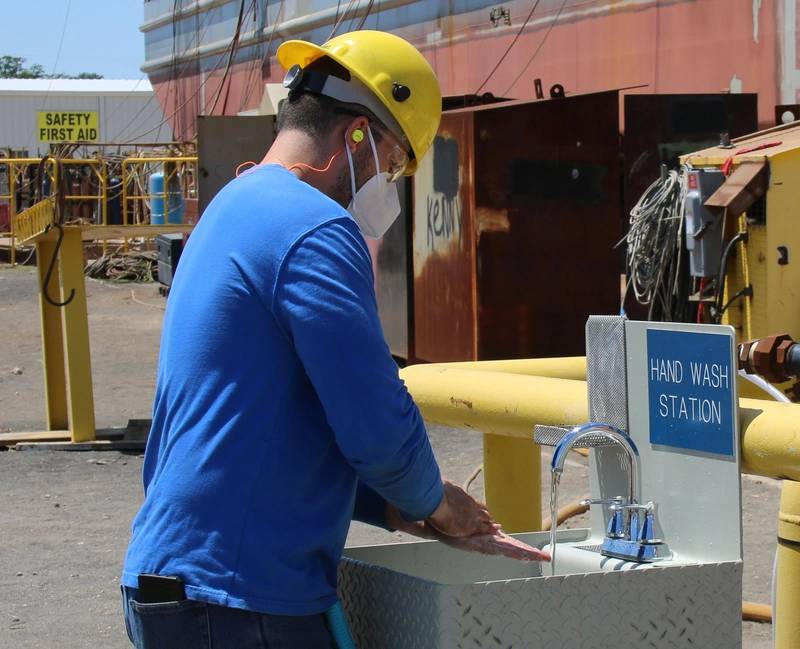 (Photo: Halter Marine)
(Photo: Halter Marine)
Please give a brief overview of Halter Marine’s current order book. How much capacity exists to take on additional projects?
It’s an exciting time in our shipyard right now. We are in various phases of construction on the U.S. Navy’s Auxiliary Personnel Lighter–Small program. We will deliver the first two APLs early next year, and the third vessel is due to be delivered after that. Construction on the fourth APL should be complete next summer. Currently, we have two Landing Craft Support vessels under construction, and we are completing the first 4,000-cubic-meter liquefied natural gas (LNG) bunkering tug/barge unit. These are all important programs. Finally, the Polar Security Cutter program will provide Halter Marine the needed base of work that will keep us viable for years to come.
We are also involved in six different studies with the government. For example, we received the Navy’s $981,000 industrial study contract for the T-AGOS class series of vessels. These ultimately will replace the existing fleet of four T-AGOS-19 and one T-AGOS-23 small waterplane area twin hull ships.
And we are also working on studies for CHAMPS, LAW, LUSV and OPC programs.
As we move into 2021, we are preparing for PSC construction and erection, but we still have plenty of capacity for additional design and construction jobs and are actively pursuing these equally important programs.
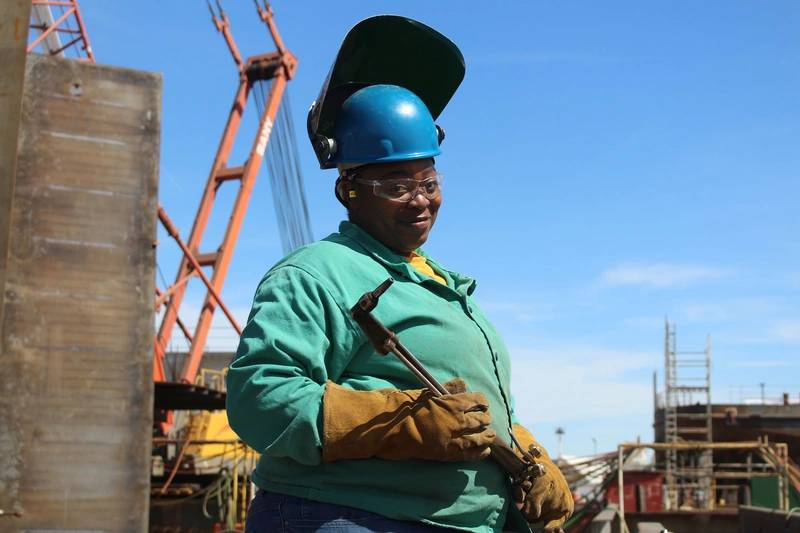 (Photo: Halter Marine)
(Photo: Halter Marine)
How do current business opportunities compare in the commercial vs government sectors, and where is Halter Marine focusing its efforts?
Our current order book is all government as the commercial market is slow at this time. We’re currently focusing on the government market where we see a large number of programs being worked on or considered that fit well into Halter Marine’s capabilities.
In addition to the several areas you mentioned previously, how is Halter Marine investing today to ensure future success?
I’ve touched on our investment in facilities and technology and how we are training people. There is one key element to this equation that deserves full attention: safety.
This spring, Halter Marine received the 2019 Safety Award from the American Equity Underwriters. I’m so proud that we are one of 25 companies to receive this prestigious safety award. It is based on very specific, measurable data, and it’s a tough competition. We have a strong safety culture here at Halter Marine, and I’m proud of the attention to health and safety demonstrated by our team every day. It truly has been an all-hands effort.
What are some of the most impactful changes you’ve observed in the shipbuilding business over the course of your career? What sort of changes do you expect we’ll see in the years ahead?
Perhaps the most impactful change our industry has seen over the years is the increase in automation on both commercial and government vessels. Trends in technology during the past several decades has been tremendous. Particularly in the area of automation. Sensor technology, information and systems control and monitoring capability, improvements in the bandwidth of data streaming through transitioning from serial to fiber optics to name just a few. All of this technology has introduced the capability to reduce manning aboard vessels, improve the ability to manage propulsion and machinery conditions and predict with certain accuracy the need for machinery and equipment overhaul and repair. These trends add great value to the owners because the technology enables improvements in operational availability and extends the potential service life of the platforms we build.
The introduction of this capability has led to a huge upswing in automation of all shipboard systems. And that has driven the costs of these vessels proportionately.
The resulting increase in upfront costs of employing these systems can sometimes be difficult to swallow for our customers. We have experienced cases where a customer will use “historical” information from previous or similar platforms to establish an expected price for a new vessel they desire. But they often times overlook the fact that the vendors selling systems and components are staying with the times by introducing these new automation features in their products. That drives up the costs for the equipment and systems. And it also drives up the shipbuilder’s costs because it requires more cables to connect and integrate these systems aboard the vessels. The costs associated with the systems engineering, functional and detail design as well as the planning and production time, test and commissioning efforts increase as well. Adding complexity and capability to platforms introduces risk, especially on first of class designs.
Another trend we have seen over the decades is the unwillingness of some customers to share in program risks. As a new program is introduced, the entire value stream is fraught with risk. Risk that has to be recognized, captured and monetized and factored into the overall program plan. Risks are captured and various risk mitigation activities are assigned. These risks are linked to the program plans and schedules and are tied to the financials. When done right, most risks are defined during the program pricing process and before the start of negotiations. What the shipbuilders would like to see is more sharing of the risks. If our customers, who clearly acknowledge the risks, would share in some of the risks, the resulting costs of programs would go down.
Affordability will remain a key discriminator in terms of competition. All shipyards are keenly aware of this. It drives our business decisions because it is directly linked to our ability to win new business. Every shipyard has a “viability” line drawn that balances the costs of the business against the revenue stream of the programs. If it is all in balance, life is good. If it is not, not so good.
We shipbuilders are a special breed. We thrive on challenges. We have tough skin because this business demands it. There is no other business that I am aware of that has so many moving parts that have to be known, and paid attention to from start to finish. The typical construction window from design through construction and delivery can take three to five years involving some 80-plus different professional and trade disciplines, all of which has to come together culminating in a finished product we all can be proud to have been a part of. That is what motivates me. That is what motivates our team here at Halter Marine.
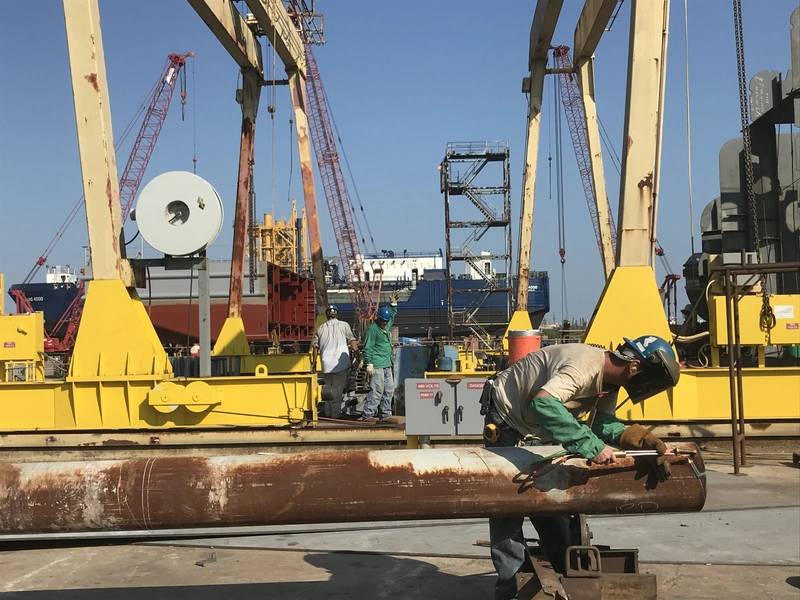 (Photo: Halter Marine)
(Photo: Halter Marine)
Read Interview: Bob Merchent, CEO, Halter Marine in Pdf, Flash or Html5 edition of October 2020 Marine News
Other stories from October 2020 issue
Content
- Interview: Bob Merchent, CEO, Halter Marine page: 11
- Bridge Heights Are Not Guesswork: Accuracy Is Imperative page: 20
- Reverse Osmosis and the New Dawn of Marine Desalination page: 22
- Working Out the Election’s Impact on the US Workboat Industry page: 22
- US Shipyards See Big Business Shifts page: 26
- US Shipyards: Always on the Job Hunt page: 34
- How is COVID-19 Influencing Passenger Vessel Design? page: 40
- Naval Fuel-related Assets Protected by Coatings and New Robust Standards page: 42
- New Towboat Gets a Complete Thordon Propulsion Package page: 44
- Tech File: oneTank Ballast Water Treatment System page: 47
- Tech File: BioBarrier MarineMBR page: 49

